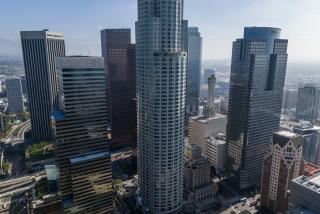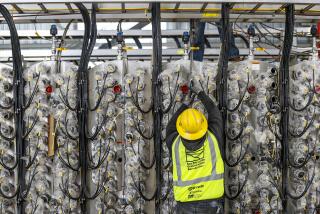Senate Hearing Will Consider Regulation of Aeration Towers
A state Senate committee hearing will be held Friday at North Hollywood High School on a proposal to regulate aeration towers, which may be used to purge San Fernando Valley ground water of toxic solvents.
The public hearing will be chaired by state Sen. Alan Robbins (D-Van Nuys), who last week introduced a bill to bar the South Coast Air Quality Management District from permitting aeration towers, or other sources of air contaminants, to operate within 100 meters of residential property. The measure also would revoke an existing air-district permit that allows the Los Angeles Department of Water and Power to erect an aeration tower in a residential neighborhood in North Hollywood.
The hearing, to be held by the Senate Select Committee on Governmental Efficiency, will be at 9:30 a.m. Friday in the auditorium of the high school at 5231 Colfax Ave. Air district and DWP officials are expected to testify. Another hearing on the bill is scheduled next Wednesday in Sacramento before the Senate Committee on Toxics and Public Safety Management.
DWP Permit at Issue
Robbins introduced the bill in response to a news report that the air district last year issued a permit to the DWP for construction of a 45-foot aeration tower at the DWP pump station at 11850 Vanowen St., which is ringed by houses and apartment buildings.
DWP officials say they had scrapped the Vanowen Street location in favor of a site in an industrial area before Robbins filed the bill.
An aeration, or air-stripping, tower is a device that uses evaporation to clean water of volatile chemicals. The water is pumped to the top of the tower and blasted with air, which removes some of the contaminants from the water but vents them into the air.
A dozen DWP water supply wells in the eastern San Fernando Valley have been shut down because of unacceptable concentrations of trichloroethylene (TCE) and perchloroethylene (PCE), both suspected cancer-causing solvents. Other less-polluted wells are being blended with clean supplies to reduce contamination to acceptable levels.
TCE and PCE are readily evaporated and air stripping is a proven way to remove them from water--but at the cost of slightly dirtier air.
Little Risk Seen
Both air-district and DWP officials contend that the tower, at the original site, would have posed an immeasurably small health risk to those living nearby.
But Laurent McReynolds, assistant chief water works engineer for the utility, said DWP officials had decided to relocate the tower to avoid raising “a sensitive public issue.”
McReynolds said the DWP had received no complaints or inquiries about the original location at the time it was abandoned in favor of the current proposed site, the DWP maintenance yard at 11875 Vose St. He said that site is about 700 feet from the nearest residential property.
Teri Burns, a Robbins aide, said the lawmaker’s concern was not limited to the Vanowen Street site. “The concern is we’re granting permits that allow” such projects in residential areas, she said.
McReynolds said that it would cost about $1 million to build the air-stripping tower and related water-collection equipment. He said DWP officials hope the tower will be operating within about two years.
A single air-stripping tower would reclaim only part of the ground water the DWP now is unable to use. DWP officials have said they may try to build more of the towers unless alternate means to strip solvents from water are perfected.
More to Read
Get the L.A. Times Politics newsletter
Deeply reported insights into legislation, politics and policy from Sacramento, Washington and beyond. In your inbox three times per week.
You may occasionally receive promotional content from the Los Angeles Times.










